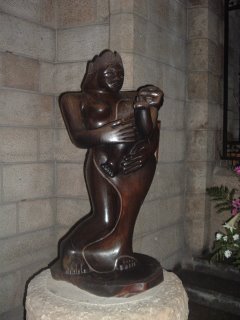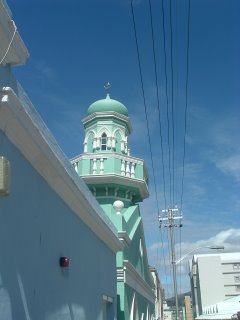More South Africa
 Black Madonna Cape Town
Black Madonna Cape TownSaints and Shamans
South Africa is a pretty religious place.
Think George Bush America on the lower intensity end and India on the high side and South Africa lands somewhere in between. From my two weeks there, seems like people there feel pretty free to frame everything from tv shows to politics in religious terms.
The white Afrikaaner and the black African communities anchor themselves in the Christian church. Hinduism and Islam are strong and active among the large Indian and 'colored' populations. And beneath all of those ‘high religions’ tribal animism thrives. Neighborhood gods and demons are never too far below the surface for many South Africans.
Even a lot of respectable black African Christians combine traditional Christianity with animism. When somebody in a township gets sick, they get prayer from their local Christian congregation but also make a point of visiting the 'shaman next door' for the appropriate rituals to ward off evil spirits.
Folks all over sub-Saharan Africa try to cover their spiritual bases. That kind of mix-and-match religion drives a lot of local Christian leaders in South Africa nuts, but it's the reality of African Christianity in spite of all the claims of a "Christianized" Africa. I guess lots of believers in Africa are so pre-modern that they're post-modern. A question this raises for me is, "When does adapting a faith like Christianity to local culture cross the line into syncretism?"
 Mosque Cape Town
Mosque Cape TownHere's a quick example of the kind of religious influence I'm talking about.
The Dutch Reformed Church played a key role in creating and re-enforcing the cruel ideology and practice of apartheid. Though a few brave Dutch Reformed leaders labeled apartheid as a “theological heresy” and played a pivotal role in ending it, that powerful church, for the most part, helped give apartheid its moral and spiritual power among the Afrikaaners.
Yet now many folks in South Africa believe the DRC contributes big to what everyone seems to call “the new South Africa.” Lots of Afrikaaners, especially those under 30, have jumped into the experiment of a multi-ethnic democratic society with both feet.
I heard an interview while I was there with Anglican Archbishop Desmond Tutu, the South African religious leader who preached steady against apartheid from the pulpit of Saint George's Cathedral in Cape Town and played such a central role in creating the healing and reconciliation that helped give the country a future. He said that the Afrikaaners, because of their religiously conservative DRC background, "have adapted to the new South Africa better than many of the white liberals who helped work with the ANC during the apartheid years."
According to Tutu, the Afrikaaner community has always seen things in polarized religious terms, and once they became convinced they were spiritually “in the wrong” many were able to “repent” and embrace a new way of life and thinking more readily than secular liberals who have now turned the same lively and rational scepticism they once used to challenge apartheid onto the The New South Africa.
Even Mandela, though not a religious man, embraced spiritual precepts like forgiveness and reconciliation so deeply that South Africa was rescued from the deaths of a lot of people. Mandela's spirituality gave "the new South Africa" moral legitimacy and a fighting chance to become a peaceful and prosperous African multi-ethnic democracy.
Or at least, that’s how lots of people in South Africa described things when I asked them about the changes they've seen over the past 15 years. They talk about things through a religious framework. Not something you hear every day here in the states.
I've gotta believe that pervasive South African religious world view explains some of their unusual hope in the face of the long odds I mentioned in my last post.
I've also gotta believe that kind of religious diversity and intensity--particularly when coupled with the extremes of wealth and poverty--could once again do some real damage if South Africa ends up with leaders with less wisdom and grace than Mandela and Tutu and others of their 'miraculous' generation. I guess only time will tell.
Artists and Shamans
I got a chance to see a unique art show called "Picasso and Africa" in Johannesburg. It was the first world class art exhibit ever held in South Africa and I got a kick out of doing the exhibit with the obviously delighted locals who came to see it. And admission was free. Sometimes you're in the right place at the right time.
P and A illustrated some of the themes I’ve been touching on in this post. The curator of the show brought together about 60 of Picasso’s works from galleries in France and displayed them along with striking examples of the kind of African tribal art that so influenced Picasso and many of the early European moderns like Matisse. The show underscored how African animistic and spiritual art undergirds much of modernist painting and sculpture.
Here are a couple of juxtaposed examples from P and A. The influence is pretty clear. The first is "Three Figures Under a Tree" by Picasso, the second a tribal mask, the third a side-by-side comparison of a Picasso piece on the left and a ritual headpiece on the right.



Pretty cool, eh?
Writing about the way African art influenced him, Picasso said, “The masks were not simply sculptures like any other. Not at all. They were magical objects.” Through them he came to view art differently. “It is not an aesthetic process; it's a form of magic that interposes itself between us and the hostile universe, a means of seizing power by imposing a form on our terrors as well as on our desires.”
Or, in other words, Picasso came to see the artist as “shaman.” And art as something full of spiritual power. He even began to speak of painting as an act of "exorcism." Those convictions drove his art throughout the rest of his life and had a decisive impact on the intensity and power of modern art.
It's kind of moving to look back to a time when artists and art lovers in the west believed that art was more than simply a decorative investment.
And whatever you think about animism or modern painting and sculpture, who would have guessed the kind of influence anonymous African tribal artists would have on the stuff most of us think of as 'fine art.'
Seemed like a lot of us in the gallery that day felt good they were finally getting their due.


2 Comments:
Yeah, I've seen a lot of art exhibits but you rarely get to see the influence of one artist or group of artists on other artists in quite this way. In the art community lots of people want to pretend they just create stuff out of thin air without much influence from others. Nice to see an exhibit set up to make the influence and the link clear. In one way it was very pre-modern since the tribal artists didn't sign their work and they strove to make their art fit pre-existing traditions and patterns. That kind of art is all about the authority of older art and communal forms.
Thanks for sharing. It made google Modigliani/Masks just to see what he did. The movie with Andy Garcia was great and I think of it when someone speaks of Picasso. Great pictures Wordcat, thanks
Post a Comment
<< Home